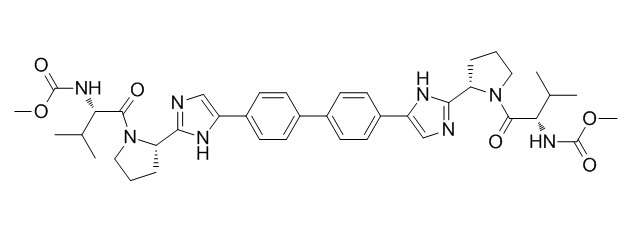Daclatasvir (BMS-790052)
Daclatasvir (BMS-790052, EBP883) is a highly selective inhibitor of HCV NS5A with EC50 of 9-50 pM, for a broad range of HCV replicon genotypes and the JFH-1 genotype 2a infectious virus in cell culture.
Inquire / Order:
manager@chemfaces.com
Technical Inquiries:
service@chemfaces.com
Tel:
+86-27-84237783
Fax:
+86-27-84254680
Address:
1 Building, No. 83, CheCheng Rd., Wuhan Economic and Technological Development Zone, Wuhan, Hubei 430056, PRC
Providing storage is as stated on the product vial and the vial is kept tightly sealed, the product can be stored for up to
24 months(2-8C).
Wherever possible, you should prepare and use solutions on the same day. However, if you need to make up stock solutions in advance, we recommend that you store the solution as aliquots in tightly sealed vials at -20C. Generally, these will be useable for up to two weeks. Before use, and prior to opening the vial we recommend that you allow your product to equilibrate to room temperature for at least 1 hour.
Need more advice on solubility, usage and handling? Please email to: service@chemfaces.com
The packaging of the product may have turned upside down during transportation, resulting in the natural compounds adhering to the neck or cap of the vial. take the vial out of its packaging and gently shake to let the compounds fall to the bottom of the vial. for liquid products, centrifuge at 200-500 RPM to gather the liquid at the bottom of the vial. try to avoid loss or contamination during handling.
Dent Mater J. 2024, dmj.2023-294.
Antioxidants (Basel).2021, 10(10):1638.
Biomimetics (Basel).2022, 7(4):154.
Appl. Sci.2022, 12(17), 8646.
J. Traditional Thai Medical Res. 2022,8(1):1-14.
Nutrients.2023, 15(4):950.
J Ethnopharmacol.2023, 313:116534.
Front Cell Dev Biol.2020, 8:32.
Molecules.2020, 25(20):4851.
Chemistry of Vegetable Raw Materials2019, 3:119-127
Related and Featured Products
Virology,2011 May 25;414(1):10-8.
The hepatitis C virus NS5A inhibitor (BMS-790052) alters the subcellular localization of the NS5A non-structural viral protein.[Pubmed:
21513964]
The hepatitis C virus (HCV) non-structural (NS) 5A protein plays an essential role in the replication of the viral RNA by the membrane-associated replication complex (RC). Recently, a putative NS5A inhibitor, BMS-790052, exhibited the highest potency of any known anti-HCV compound in inhibiting HCV replication in vitro and showed a promising clinical effect in HCV-infected patients. The precise mechanism of action for this new class of potential anti-HCV therapeutics, however, is still unclear.
METHODS AND RESULTS:
In order to gain further insight into its mode of action, we sought to test the hypothesis that the antiviral effect of BMS-790052 might be mediated by interfering with the functional assembly of the HCV RC. We observed that BMS-790052 indeed altered the subcellular localization and biochemical fractionation of NS5A.
CONCLUSIONS:
Taken together, our data suggest that NS5A inhibitors such as BMS-790052 can suppress viral genome replication by altering the proper localization of NS5A into functional RCs.
Antimicrob Agents Chemother,2005 Apr;49(4):1346-53.
Development of a cell-based high-throughput specificity screen using a hepatitis C virus-bovine viral diarrhea virus dual replicon assay.[Pubmed:
15793110]
The peptide (Ac-Asp-Glu-Asp [EDANS]-Glu-Glu-Abu-[COO] Ala-Ser-Lys [DABCYL]-NH2) contains a fluorescence donor {EDANS, 5-[(2-aminoethyl)amino]naphthalene-1-sulfonic acid} near one end of the peptide and an acceptor {DABCYL, 4-[(4-dimethylamino)phenyl]azo)benzoic acid} near the other end. Intermolecular resonance energy transfer between the donor and the acceptor quenches the fluorescence of the peptide, but as the NS3 protease cleaves the peptide, the products are released from resonance energy transfer quenching. The fluorescence of the donor increases over time as more substrate is cleaved by the NS3 protease. The assay reagent is: 5× luciferase cell culture lysis reagent diluted to 1× with dH2O, NaCl (150 mM), the FRET peptide (20 μM). HCV-Huh-7 cells are placed in a 96-well plate, and allowed to attach overnight (1×104 cells per well). The next day, BMS-790052 is added to the wells and the plate is incubated for 72 hours. The plate is then rinsed with PBS and used for the FRET assay by the addition of 30 μL of the FRET peptide assay reagent (described above) per well. Signals are obtained using the Cytofluor 4000 instrument, which has been set to 340 nm (excitation)/490 nm (emission) automatic mode, for 20 cycles or less, with the plate being read in the kinetic mode. Following FRET, 40 μL of luciferase substrate is added to each well and the luciferase is measured.
Nature,2010 May 6;465(7294):96-100.
Chemical genetics strategy identifies an HCV NS5A inhibitor with a potent clinical effect.[Pubmed:
20410884]
Cell lines:HCV replicon cells (Huh7)
Concentrations: 0.1 pM - 50 μM, dissolved in DMSO (the final concentration of DMSO is 0.5%)
Incubation Time: 72 hours
Method:
BMS-790052 is added to 96-well plates containing HCV replicon cells seeded approximately 12 hours before in 200 µL media.The cell plates are tested for replication activity and cytotoxicity after 72 hours of incubation. Cytotoxicity is measured with CellTiter-Blue, after which the media and dye are removed, plates are inverted and the remaining liquid is blotted with paper towels. Replication activity of the HCV genotype 1a cell lines is quantified using Renilla luciferase. 1× Renilla luciferase lysis buffer (30 µL) is added to each well and plates are incubated with gentle shaking for 15 min. Renilla luciferase substrate (40 µL) is then added and the signals are detected using a Top Count luminometer set for light emission quantification. One hundred per cent activity is calculated for each cell line for the DMSO-only wells; percentage activity is calculated for each concentration of the inhibitor by dividing the average value for wells containing compound by the average value for wells containing DMSO.



